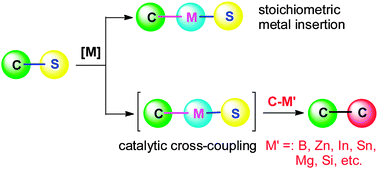Transition-metal mediated carbon–sulfur bond activation and transformations
Abstract
C–S bond

* Corresponding authors
a
Dalian Institute of Chemical Physics, Chinese Academy of Sciences (CAS), 457 Zhongshan Road, Dalian, China
E-mail:
zkyu@dicp.ac.cn
b State Key Laboratory of Organometallic Chemistry, Shanghai Institute of Organic Chemistry, CAS, 354 Fenglin Road, Shanghai 200032, China
C–S bond

 Please wait while we load your content...
Something went wrong. Try again?
Please wait while we load your content...
Something went wrong. Try again?
L. Wang, W. He and Z. Yu, Chem. Soc. Rev., 2013, 42, 599 DOI: 10.1039/C2CS35323G
To request permission to reproduce material from this article, please go to the Copyright Clearance Center request page.
If you are an author contributing to an RSC publication, you do not need to request permission provided correct acknowledgement is given.
If you are the author of this article, you do not need to request permission to reproduce figures and diagrams provided correct acknowledgement is given. If you want to reproduce the whole article in a third-party publication (excluding your thesis/dissertation for which permission is not required) please go to the Copyright Clearance Center request page.
Read more about how to correctly acknowledge RSC content.
 Fetching data from CrossRef.
Fetching data from CrossRef.
This may take some time to load.
Loading related content
